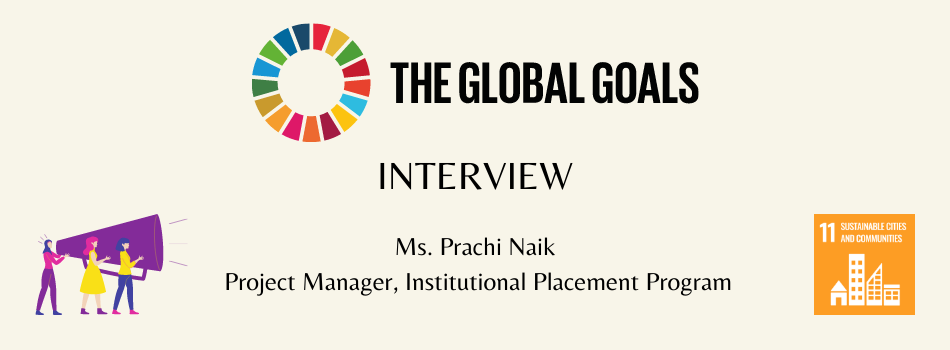
SDG Goal 11- Understanding Prerana's Initiatives in Developing the Aftercare Care Model
Shatakshi Saxena
Project Coordinator (Documentation and Communications)
Ms. Prachi Naik joined Prerana in 2006 and has been a part of our team for almost 15 years now. She is the Project Manager of our Institutional Placement Program and closely works with children in need of care and protection. She coordinates with various stakeholders for the admission of children in need of care and protection in Children’s Homes, prepares social investigation reports, individual care plans and conducts follow-ups to ensure their holistic development.
How do you think Prerana’s Aftercare Care Model contributes to Target 11.1, i.e., By 2030, ensure access for all to adequate, safe, and affordable housing and basic services?
Prerana has worked intensively since 2000 to rehabilitate minor girls rescued from the sex trade. After the initial healing and self-reintegration, it was seen that the victims of sex trafficking and physical and sexual violence suffer from a variety of mental illnesses such as anxiety, depression, Post-Traumatic Stress Disorder (PTSD), aggression, self-destructive tendencies, etc. In this context, self-reintegration refers to the process of physical and mental recovery of the victim through medication and psychosocial counseling. This self-reintegration is important to help victims move to the next goal, which is social reintegration. While the vocational trainings they were linked to ensured that the rescued victims could get jobs in Mumbai, it also posed the challenge of finding a safe place for them to live. Not all victims who received training through us were willing to return to their families or native places fearing rejection and other safety concerns. Others were either orphaned or did not have any support system to fall back upon. Some of them also felt the need to earn money and gain some work experience before returning to their families.
In some of these cases, children are rescued placed in an institution when they’re already 17, and get very little time to benefit from the protection. There is also not enough time to assess their needs and develop a safety and reintegration plan for them. In 2003, Prerana in collaboration with Our Children (Civil Society Organization), focused on Aftercare in a more sustained and holistic manner. Since 2017, this program became more comprehensive that included our team orienting children residing in various Child Care Institutions (CCIs) on the program when they turn 16. Once a group of four to five girls is formed, our team starts to look for affordable and safe housing options for them. Whenever possible, the care leavers are involved in this process. We try to ensure that the locality is safe, has easy access to local transport, is closer to the employment addresses of the girls and that they feel secured in the setup. We believe Aftercare is an essential care model to ensure that the girls are able to reintegrate into the society better. Our team also launched the Aftercare Care Model document on Trafficking in Persons Day this year that elaborates on its various needs and Prerana’s Best Practices.
Prerana’s Aftercare model caters to the primary need of a child moving out of the Juvenile Justice System i.e. shelter. Can you please elaborate on how does Prerana’s Aftercare Care Model fulfil a care leavers need for shelter?
When youth care leavers express interest for our Aftercare program, our team’s priority is to find group homes that are safe, and affordable. Currently, we don’t run our own group home but are engaged in Externally-Assisting Group Homes. In our experience, some girls may be already employed, or have finalized on jobs and share that they would like to live in areas closer to their workplace. As a best practice, our team checks the legal validity of the property, and conducts a background check of the real estate agent and owner. We also facilitate the signing of the lease agreement between the residents and the owner, and also assign a local guardian who is known to us, and resides close to the facility. Additionally, we also assist with paying the security deposit for the facility and rent up to one year, if required. Our team also orients the residents on the society rules and conducts timely follow-ups with them. If they ever wish to leave the facility, we assist them with the process. We also refer youth care leavers to other organizations after assessing their needs. Our aim is to ensure that no female youth care leaver is left without shelter because they don’t have a family or don’t want to return to a family as they don’t feel safe there.
In what ways does the Aftercare facility help in the holistic development of young adults who have been in an institutional setup?
When the young adults exit the institutional setup, their lifestyle changes in various aspects. Prerana assists and supports the care leavers during their transition from children’s homes to independent living. When they start residing at Group Homes, they get the opportunity to understand and implement financial management, including budgeting. All the residents calculate the monthly wages and their expenses and learn to equally divide responsibility and resources amongst each other. It is their first experience of independently handling their living. Secondly, they learn to respect and understand each other’s personal space, boundaries and comfort zones. It also gives them an opportunity to assess their own safety and how to manage their long term shelter requirement. The Group Home setup provides them with a safe space to be able to explore themselves, experience independent co-living and safely reintegrate into the society.
What are the challenges that come in the way while searching for safe housing for girls from vulnerable backgrounds in Tier 1 cities?
The foremost challenge we face is those renting their house and the neighborhood are skeptical about the “character” of the women, the fact that the care leavers are young, working girls and their in and out timings. Sometimes we come across people who have religious and caste related biases towards marginalized and minority communities which is a major hindrance. Another challenge faced is that the distance between their workplace and Group Home might be time consuming, and the traveling cost increases for the care leavers. Rent of accommodations closer to the city and formal workplaces might be expensive. Sometimes, the difference in lifestyle of residents also creates problems between them, and we orient them on various fronts such as the rules of the Group Home and the importance of understanding each other’s opinions, societal expectations, importance of maintaining and spelling out boundaries etc. We have also experienced that flat owners don’t like to rent their houses to women who return late in the night or have male friends visiting them.
Having worked on the Aftercare program for over 5 years, can you share the suggestions that you have received from care leavers to strengthen the Aftercare support?
Some of the suggestions received from care leavers are that only girls who are interested in getting a job or those who already have a source of income should be included in such Group Homes so they are able to contribute to its functioning. Another important suggestion we received was that the Group Home should be in proximity of the local train or bus stations that will make traveling to their workplace easier. Some care leavers also shared that if the Group Home is closer to the residence of a resource person, it will be comforting if an unforeseen situation arises. They also like to be engaged in the process of selection of the GH premise. The care leavers are also keen that the residents share with each other an emergency contact for each other just in case it is required. Our team has been ensuring to incorporate these suggestions and make it more accessible for the care leavers.
This is the fifth interview in the ten-month long series on Prerana’s commitment to sustainable development goals. Watch this space for more.
To be or not to be? Questions on motherhood searching answers
Children look forward to spending Mother’s Day at their home with their mothers. While many have that opportunity, children living Read more
This series focuses on the issues related to the education of the marginalized children and the cumulative inequalities that are Read more



